Focus on Physics
Physics in the Sport of Boxing—A Personal Story
Paul G. Hewitt
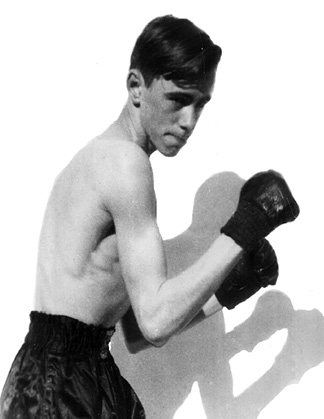
The author at age 17.
I grew up in a neighborhood not far from Boston at a time when boxing was more popular than baseball, basketball, and football combined. That was before the advent of television; my passion as a teenager was boxing.
A love of boxing
Boxing as my sport of choice was prompted by school bullies preying on me, as the skinniest kid in school, and also by the good fortune of having Eddie McCarthy, a lightweight amateur boxer as my next-door neighbor. Eddie was happy to indulge me in sparring sessions that I greatly valued. When he enlisted in the Army, he asked his friend and fellow lightweight boxer Kenny Isaacs to take me under his wing. It was absolutely wonderful, for I was one of many who greatly admired Kenny’s proficiency in boxing bouts in Lynn Arena, near my home in Saugus, Massachusetts.
During one such bout when I was 14, I looked with admiration at a boy whose task was bringing a water bucket up to Kenny between rounds. I wished I could have that task. Fast forward to age 17 and Kenny Isaacs was in my corner at the annual boxing championships of the New England Amateur Athletic Association in Boston Arena.
Energy and boxing
Well before I entered a life of science, my intuition regarding energy conservation was evident: I didn’t prance around shadow boxing before the first bell rang. Prancing and tossing punches in the air consumes energy—valuable energy that should be saved for the fight. Whoever runs lower on that supply of energy will be unlikely to win that bout. I devoted my store of energy to the three rounds of boxing. I was fast on my feet and punched quickly, mastering the left jab, but I lacked the strength of a better boxer.
Nonetheless, I won in the quarterfinals on the first evening of the tournament. On the following day there were two bouts closer to the gold medal—the semifinals and the finals. In the semifinals, opponent Mike Filipon, a specialist in body punching, savagely beat me to exhaustion. However, I outpointed him and won by a unanimous decision.
My store of energy was low two hours later when I fought Ted St. Jean of Rhode Island in the finals. Kenny, in my corner, was ecstatic at the end of the first round when he said I won the round. But the toll from the Filipon bout left me with a “stitch” in my groin—the dreaded stitch that comes when you run too far without resting. I was low on energy and couldn’t finish the second round. I won the silver medal, which I value to this day.
Knocked out (of boxing)
In a bout a few months later I was knocked out by a single punch thrown by Franny Walsh, a 27-year-old whom I had beaten in an earlier encounter. Franny simply dashed across the ring at the opening bell. I never saw that punch coming. He later told me that he’d never hit a person as hard as he did that night. I was unconscious for minutes, holding up the program. That was my last amateur boxing bout. A letter from the boxing commission informed me: No more bouts for one year. I extended that one year to a lifetime.
Physics: structured common sense
Any physics I applied to boxing was merely common sense. Today, I like to say that physics is structured common sense. As an example, everybody knows that if you’re in a fast-moving, out-of-control truck that can be stopped only by hitting a haystack or hitting a brick wall, the haystack is the obvious choice. How much more interesting to know why that common-sense choice is correct.
Additionally, it is engrossing to know the why of the many happenings in our everyday lives! Let’s take a closer look at the out-of-control truck in terms of impulse and momentum, and then apply that to boxing.
Linear momentum, which I refer to as inertia of motion, is defined as mass multiplied by velocity, mv. The speeding truck possesses both mass and velocity. To change its momentum requires what we call an impulse—Ft, force multiplied by the time of contact of that force. In shorthand notation, Ft = ∆mv.
Hit the haystack
We see in Figure 1 that the truck’s momentum is reduced to zero by an impulse, Ft. If the truck slams into a haystack, the extended time of contact means that the force is correspondingly small. On the other hand, if the truck slams into a massive wall, the time of contact is short and the force of impact is huge. This is common sense, and no structured thinking is needed in choosing the haystack.
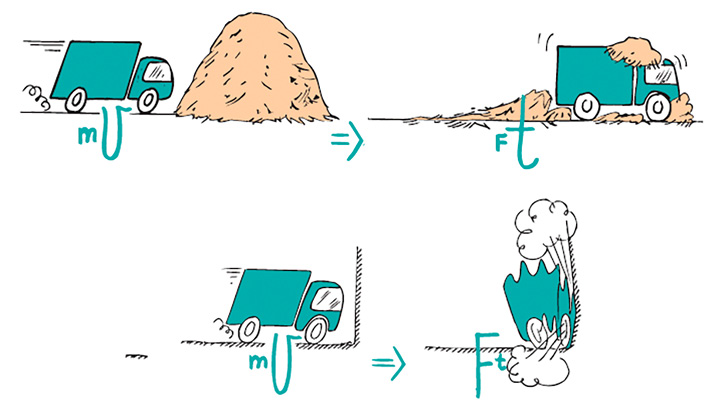
The momentum of the truck is brought to a halt by an impulse provided by a haystack and by a massive wall.
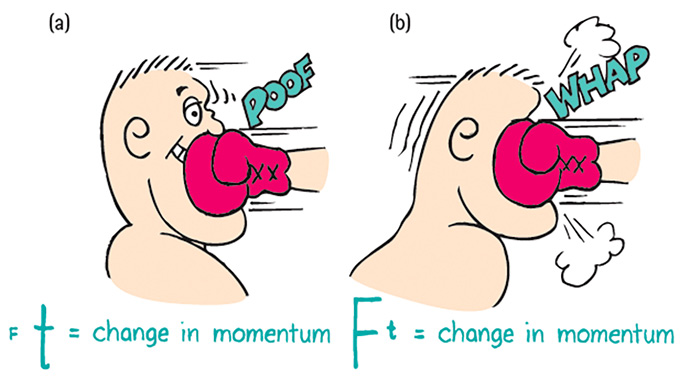
The momentum of the boxer is affected by the impulse of an oncoming punch.
However, a bit of structure comes in handy in answering these questions: Is the change in momentum for these two cases equal? Are the two impulses that stop the truck equal? Letting Ft = ∆mv guide our thinking, we can say yes to both questions. What is different are the relative amounts of force and time. Very interesting physics, especially when applied to boxing.
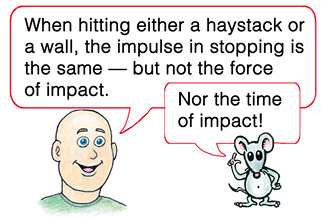

Ride with the punch
In Figure 2 we see the effect of a punch delivered to an opponent, and, as with the truck of Figure 1, the importance of time. Whether moving toward or away from the punch, momentum undergoes a change. When the boxer moves away, he “rides with” the punch and extends the time during which the punch is applied. This is very advantageous, for the extended time means diminished force (Figure 2a). On the other hand, if the boxer moves toward the gloved fist, the time of contact is reduced and the force is correspondently increased (Figure 2b). Every good boxer is well aware of this, although not necessarily in formal terms.
Another point about momentum: The momentum of a punch is not the mass of the fist times its velocity, but rather the mass of part of the boxer’s body multiplied by the velocity of the fist. A boxer puts his body, not merely his arm, into a good punch. Such a punch delivers more impact.
Expended energy
When boxing, more energy is consumed when missing punches than when connecting. A boxer can punch a heavy bag all afternoon in the gym and barely tire. But a few minutes in the ring with an opponent is another story. Why the difference? I had figured this out in my pre-science years. You expend energy when you throw a punch. You also expend energy when you stop the motion of the punch. Every time you miss a punch with an opponent, you expend more energy than if the punch landed.
Back to the gym: What stops the punches you throw against a punching bag? The answer is, the bag stops the punches. What stops the punches you throw at an opponent who dodges your punches? The answer is you. We’ve all seen boxers who “punch themselves out” when throwing a barrage of punches at an opponent who bobs and weaves and escapes most of the onslaught. The conservation of energy reigns.
Newton’s third law
When a boxer hits a massive punching bag, his gloved fist hits the bag (and dents it) while the bag hits back on the fist (and stops its motion). Newton’s third law tells us that forces occur in pairs, one an action force and the other a reaction force. The pair of forces involved in hitting the bag can be huge. But when the boxer hits a piece of tissue paper in midair, the pair of forces is tiny. In both cases, the boxer’s fist can only exert as much force on the bag or the tissue paper as those objects can exert on the fist (Figure 3).
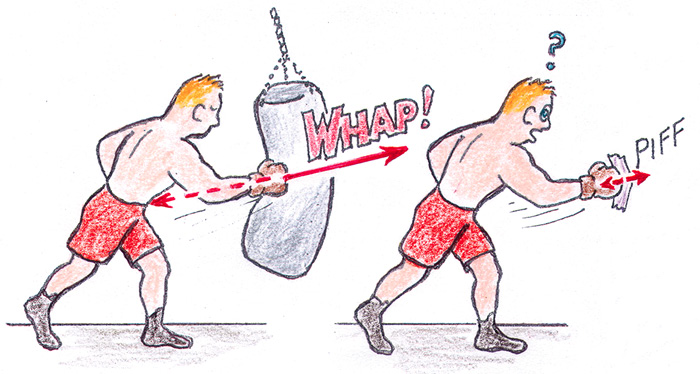
The boxer exerts a sizable force on the bag, but with the same punch he can exert only a tiny force on the tissue paper in midair.
Punching force on the big guy and the small guy
Question: In boxing, which of your hardest-thrown punches would exert more force? One to an opponent less massive than you? Or to an opponent more massive than you? Answer: Greater force for the same punch is delivered to the heavier opponent. Why? For the same reason greater force is exerted against a heavy punching bag than to a piece of tissue paper in midair! For the massive bag and tissue paper, the answer is obvious. For smaller differences in mass, the same principle applies: You cannot hit something harder than that something can hit back. A force cannot exist without an equal and opposite reaction force. That’s the law. In this case, knowledge of the law is very helpful.

Life after boxing
A fortunate series of events followed my boxing career, and after stints at sign painting and silkscreen printing, the big event was being drafted into the United States Army. Because I weighed only 112 pounds, I flunked the selective service physical exam in 1952. Interestingly, my boxing was in the 112-pound class—flyweight. I never had a problem with the physical exams required before a bout. So I was not drafted into the Army when the Korean conflict was in full swing.
A year later, I was again called for a physical exam. Again, my normal weight at the time was 112 pounds. The examining doctor believed I was purposely dieting to evade being drafted and stamped “ACCEPTED” on my examination report. In 1953 I was inducted into the Army—one year after my boxing mentor, Eddie McCarthy, was killed in action in Korea.
Korean aftermath
I was lucky to never see combat because hostilities came to a halt on the last day of my basic training in Camp Carson, Colorado. I remained in Colorado to take part in the uranium prospecting craze that was popular at the time (unsuccessfully.) I financed my prospecting adventure by painting signs in the small Colorado town of Salida.
Inspirations
As winter approached I made a second trip to Florida where I met and was greatly influenced by sign painter Burl Grey and his visionary friend Jacque Fresco. Their enthusiasm for science inspired me to take advantage of the G.I. Bill and to return to Massachusetts to receive an education in physics.
After two years of prep school, because my high school classes hadn’t included the needed science and math, I entered Lowell Technological Institute at age 28. After earning a BS in physics, I moved west to attend Utah State University, where I was further inspired by extraordinary professors Farrell Edwards and John Merrill.
In 1964, after receiving an MS in physics, City College of San Francisco hired a former boxer into their physics department. There, my teaching career flourished because I was doing what I loved—sharing my passion for physics and teaching others to see the world through the lens of science. I felt that nobody enjoyed teaching physics as much as I did.
Retirement
What to do after retiring from classroom teaching? Periodically revise my textbooks and write a monthly column, Focus on Physics, for The Science Teacher—like this one. My passion for classroom teaching has wonderfully morphed into writing about it. Life is good—extraordinarily good!
On the Web
Tutorial screencasts are on www.HewittDrewIt.com, and on www.ConceptualAcademy.com.
Paul G. Hewitt (pghewitt@aol.com) is the author of Conceptual Physics, 12th edition; Conceptual Physical Science, 6th edition, coauthored with daughter Leslie Hewitt and nephew John Suchocki; and Conceptual Integrated Science, new 3rd edition, with coauthors Suzanne Lyons, John Suchocki, and Jennifer Yeh.
Physical Science Physics High School


